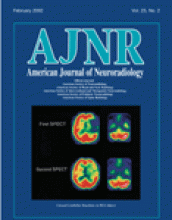Abstract
BACKGROUND AND PURPOSE: Initially decreased apparent diffusion coefficient (ADC) values are reversible if reperfusion is rapidly performed after focal brain ischemia. We sought to determine if reperfusion-induced renormalization of initially abnormal values indicates reversal of cellular, morphologic changes that occur during acute ischemia.
METHODS: Eighteen rats underwent 30 minutes of middle cerebral artery occlusion (MCAO) without reperfusion (group A, n = 6), with 1.5 hours of reperfusion (group B, n = 6), or with 12 hours of reperfusion (group C, n = 6). Diffusion- and perfusion-weighted MR images were obtained at the end of MCAO and 1.5 and 12 hours after reperfusion. Immediately after the final MR study, the brains were fixed by cardiac perfusion with 4% paraformaldehyde. Neuronal injury was evaluated on hematoxylin-eosin-stained slices, and astrocytic size was determined by the area of glial fibrillary acidic protein (GFAP) plus S-100 expression.
RESULTS: In group A in which ADC values decreased significantly, 47 ± 12% of the neurons were slightly shrunken; astrocytes were moderately swollen, and the area expressing GFAP plus S-100 was larger than that in the contralateral hemisphere (117 μm2 ± 6 vs 89 μm2 ± 2; P < .001). In group B in which ADC had renormalized, most neurons were moderately shrunken, and the frequency of such neurons was greater in group B (92% ± 2) than in group A (P < .001); astrocytes were markedly swollen, and the area was larger than that in the contralateral hemisphere (123 μm2 ± 8 vs 85 μm2 ± 4, P < .001). In group C in which a secondary ADC decrease occurred, most neurons (94% ± 3) were severely shrunken, and some had eosinophilic cytoplasm; astrocytes were disintegrated, and the area of GFAP plus S-100 expression was reduced (78 μm2 ± 4 vs 90 μm2 ± 5, P < .001).
CONCLUSION: Reperfusion-induced acute renormalization of ADC values is not associated with the reversal of neuronal shrinkage and astrocytic swelling that occur during ischemia. Conversely, the morphologic changes of astrocytes and neurons progressively worsen over time, although ADC values show a biphasic change.
- Copyright © American Society of Neuroradiology












